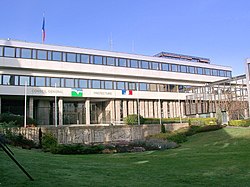Top Qs
Timeline
Chat
Perspective
Côtes-d'Armor
Department of France From Wikipedia, the free encyclopedia
Remove ads
The Côtes-d'Armor (/koʊt dɑːrmər/ koht dar-mər, /-dɑːrmɔːr/ -dar-mor; French pronunciation: [kot daʁmɔʁ] ⓘ; Breton: Aodoù-an-Arvor, [ˈoːdu ãn ˈarvor]), formerly known as Côtes-du-Nord until 1990 (Breton: Aodoù-an-Hanternoz, [ˈoːdu ãn ˌhãntɛrˈnoːs]), is a department in the north of Brittany, in northwestern France. In 2019, it had a population of 600,582.[3]
Remove ads
History
French Revolution
Côtes-du-Nord was one of the original 83 departments created on 4 March 1790 following the French Revolution. It was made up from the near entirety of the ancient Pays de Saint-Brieuc, most of historical Trégor, the eastern half of Cornouaille, and the north-western part of the former diocese of Saint-Malo. The area had been part of the Province of Brittany before 1790.
World War II
During the Second World War, Côtes-d'Armor was occupied by the Nazis and was the site of French Resistance operations, such as Operation Samwest, around the time of the Normandy landings.[4]
Post-War
On 27 February 1990, the name was changed to Côtes-d'Armor; the name is a portmanteau of the French word côtes means "coasts" and ar mor is "the sea" in Breton. The name also recalls that of the Roman province of Armorica ("the coastal region").
Remove ads
Geography
Summarize
Perspective
Côtes-d'Armor is part of the current administrative region of Brittany and is bounded by the departments of Ille-et-Vilaine to the east, Morbihan to the south, and Finistère to the west, and by the English Channel to the north.
The region is an undulating plateau including three well-marked ranges of hills in the south. A granitoid chain, the Monts du Méné, starting in the south-east of the department runs in a north-westerly direction, forming the watershed between the rivers running respectively to the English Channel and the Atlantic Ocean. Towards its western extremity this chain bifurcates to form the Montagnes Noires in the south-west and the Monts d'Arrée in the west of the department. Off the coast, which is steep, rocky and much indented, are the Jentilez, Bréhat and other small islands. The principal bays are those of Saint-Malo and Saint-Brieuc.[5]
Principal towns
The most populous commune is Saint-Brieuc, the prefecture. As of 2019, there are 6 communes with more than 10,000 inhabitants:[3]
Remove ads
Demographics
The inhabitants of the department are known in French as Costarmoricains.
Politics
Summarize
Perspective
Côtes-d'Armor's long tradition of anti-clericalism, especially in the interior around Guingamp (a former Communist stronghold), has often led to the department's being seen as an area of left-wing exceptionalism in a region that historically was otherwise strongly Catholic and right-wing. The current president of the departmental council, Christian Coail, is a member of the Socialist Party.
Current National Assembly Representatives
Remove ads
Culture
The western part of the department is part of the traditionally Breton-speaking "Lower Brittany" (Breizh-Izel in Breton). The boundary runs from Plouha to Mûr-de-Bretagne. The Breton language has become an intense issue in many parts of Brittany, and many Breton-speakers advocate for bilingual schools. Gallo is also spoken in the east and is offered as a language in the schools and on the baccalaureat exams.
Remove ads
Gallery
- Castel Meur house in Plougrescant
- Statue of Bertrand du Guesclin in Dinan
Notable people
- Anne Beaumanoir (1923–2022), one of the Righteous Among the Nations, was born in Guildo.
- Bernadette Cattanéo (1899–1963), trade unionist and militant communist
- English-born poet Robert William Service (1874–1958), known as the "Bard of the Yukon", is buried in Lancieux.
See also
References
External links
Wikiwand - on
Seamless Wikipedia browsing. On steroids.
Remove ads









